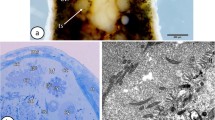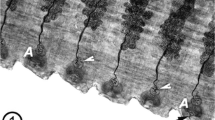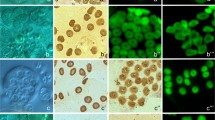Abstract
The ultrastructural changes in the ejaculatory duct epithelium in Glossina morsitans morsitans Westwood was examined for special features related to spermatophore formation; special attention was paid to the cytoplasmic organelles and the plasma membrane specializations (apical infoldings and space formation). Internally, the transportation system is characterized by a cuticle-lined lumen bordered by cuboidal cells. The endoplasmic reticulum is scarce, while mitochondria are distributed throughout the cytoplasm. At the cuticular surface of the cells, extensive apical infoldings are associated with numerous mitochondria. Glycogen granules are found only in the cytoplasm of teneral flies. Apically, adjacent cells are tightly apposed; however, prominent intercellular spaces develop (1 to 7 days), permeate most of the epithelium and connect to the basal surface of the cells. These are features characteristic of transporting cells believed to have an absorptive function. As the adult fly ages, the ultrastructural characteristics of the epithelium change and are typified by the disappearance of glycogen granules and the formation of intercellular spaces. The features of the ejaculatory duct are discussed briefly in terms of their role in spermatophore formation.
Résumé
Cette étude décrit des changements ultrastructurelles dans l’épithelium du vaisseau éjaculatoire de Glossina morsitans Westwood pendant les sept premiers jours après éclosion. Le système de transport est caractérisé a l’intérieur par un lumen cutico-linéaire bordé des leucocytes cubiques. Le réticulum endoplasmique n’est pas abondant alors que les mitochondries sont reparties à travers tout le cytoplasme. Sur la surface apicale des leucocytes, plusieurs plissages sont associés a des vastes mitochondries. Des granules de glycogene ont été observées seulement dans le cytoplasme des jeunes mouches. Des changements ultrastructurelles de l’épithelium sont caractérisés par la disparition des granules de glycogene et la formation des espaces inter cellulaires en rapport avec l’âge. Des leucocytes apicalement adjacentes sont étroitement apposés, mais des espaces intercellulaires se developent (mouches âgées de 1–7 jours), sont répandues sur l’épithelium et sont jointes à la surface basala des leucocytes. Ces traits sont caractéristiques des leucocytes transporteurs qu’on croit avoir aussi une fonction d’absorption. Les traits du vaisseau ejactulatoire sont ainsi décrits quant à leur rôle dans la formation du spermatophore.
Similar content being viewed by others
References
Anderson E. and Harvey W. R. (1966) Active transport by the cecropia midgut—II. Fine structure of the midgut epithelium. J. Cell Biol. 31, 107–273.
Bairati A. (1968) Structure and ultrastructure of the male reproductive system in Drosophila melanogaster Meig. 2. The genital duct and accessory glands. Monit. Zool. Ital. (N.S) 2, 105–182.
Berridge M. J. and Oschman J. L. (1972) Transporting Epithelia. Academic Press, New York.
Chapman R. F. (1982) The Insects Structure and Function, third edition. Hodder and Stoughton, Hong Kong.
Chen P. S. (1984) The functional morphology and biochemistry of insect male accessory glands and their secretions. A. Rev. Ent. 29, 233–255.
Cioffi M. (1979) The morphology and fine structure of the larval midgut of a moth (Manduca sexta) in relation to active transport. Tissue Cell II., 467–479.
Copeland E. (1964) A mitochondrial pump in the cells of the anal papillae of mosquito larvae. J. Cell Biol. 23, 253.
Doyle W. L. (1960) The principal cells of the salt-gland marine birds. Exp. Cell Res. 21, 386.
Dimitriadis V. K. and Kastritsis C. D. (1984) Ultra-structural analysis of the midgut of Drosophila auraria larvae. Morphological observations and their physiological implications. Can. J. Zool. 62, 659–669.
Fawcett D. W. (1966) The Cell. In An Atlas of Fine Structure. W. B. Saunders, Philadelphia and London.
Gillott C. and Ahmed I. (1986) Ejaculatory duct of migratory grasshopper, Melanoplus sanguinipes (Fabr.). (Orthoptera: Acrididae). A histological and ultra-structural analysis. Int. J. Insect Morphol. Embryol. 15, 293–309.
Gregory G. E. (1965) The formation and fate of the spermatophore in the African migratory locust, Locusta migratoria migratorioides Reiche. and Fairmaire. Trans. R. Ent. Soc. Lond. 117, 33–66.
Kokwaro E. D. and Odhiambo T. R. (1981) Spermatophore of the tsetse, Glossina morsitans morsitans Westwood.: An ultrastructural study. Insect Sci. Applic. 1, 185–190.
Leopold R. A. (1970) Cytological and cytochemical studies on the ejaculatory duct and accessory secretions in Musca domestica. J. Insect Physiol. 16, 1859–1972.
Leopold R. A. (1976) The role of male accessory glands in insect reproduction. A. Rev. Ent. 21, 199–221.
Meola S. M. (1982) Morphology of the region of the ejaculatory duct producing the male accessory gland material in the stable fly, Stomoxys calcitrans L.. (Diptera: Muscidae). Int. J. Insect Morphol. Embryol. 11, 69–77.
Norman T. C. (1965) The neurosecretory system of the adult Calliphora erythrocephala. 1. The fine structure of the corpus cardiacum, with some observations on adjacent organs. Z. Zellforsch. Mikrosk. Anal. 67, 461–501.
Odhiambo T. R., Kokwaro E. D. and Sequeira L. M. (1983) Histological and ultrastructural studies of the male accessory reproductive glands and spermatophore of the tsetse Glossina morsitans morsitans Westwood.. Insect Sci. Applic. 4, 227–236.
Pease D. C (1956) Infolded basal plasma membranes found in epithelia noted for their water transport. J. Biophysic. Biochem. Cytol. 2, 203.
Pollock J. N. (1974) Male accessory secretions, their use and replenishment in Glossina (Diptera: Glossinidae). Bull. ent. Res. 64, 533–539.
Rhodin J. (1954) Correlation of ultrastructural organization and function in normal and experimentally changed proximal convoluted tubule cells of the mouse kidney, Aktiebolaget Godvil, Stockholm.
Rhodin J. (1958) Anatomy of kidney tubules. Int. Rev. Cytol. 7, 485.
Riemann J. G. (1973) Ultrastructure of the ejaculatory duct region producing the male housefly accessory material. J. Insect Physiol. 19, 213–223.
Scharrer B. (1968) Neurosecretion—XIV. Ultrastructural study of sites of release of neurosecretory materials in blattarian insects. Z. Zellforsch 89, 1–16.
Viscuso R., Longo G. and Sottile L. (1985) Ultrastructural modifications in the ejaculatory duct epithelium of Eypre-pocnemis plorans. Int. J. Insect Morphol. Embryol. 14, 163–177.
Author information
Authors and Affiliations
Rights and permissions
About this article
Cite this article
Kokwaro, E.D., Murithi, J.K. Ultrastructural Characteristics of the Ejaculatory Duct of the Male Tsetse, Glossina morsitans morsitans Westwood. Int J Trop Insect Sci 9, 475–482 (1988). https://doi.org/10.1017/S1742758400010997
Received:
Revised:
Published:
Issue Date:
DOI: https://doi.org/10.1017/S1742758400010997




